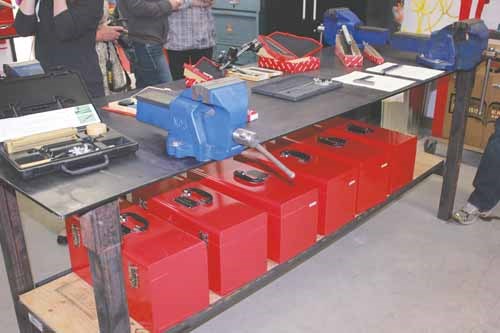For decades rural Saskatchewan has seen a net loss of population, particularly among youth. Back in the 1960s and 1970s, the hope was that young people who left to pursue post-secondary education would return to their home communities, but StatsCan reports the ones who actually have number 25 per cent at best.
Five years ago, Bob Haacke and Warren Kaeding, two members of the Churchbridge Public School (CPS) School Community Council (SCC) decided to do something about the youth drain for their town of 700 people located 54 kilometres southeast of Yorkton.
"Both Bob and I had two sons that were somewhat frustrated with just the general industrial arts class that they were taking," Kaeding said. "All of our boys were quite interested in furthering their education in the skilled trade area and we just felt it was unfortunate that they didn't have that opportunity in high school to really pique their interest."
On June 6, Kaeding's and Haacke's dream of establishing a Practical and Applied Arts (PAA) program for local Grades 10, 11 and 12 students became reality with the opening of the CPS Millwrights and Industrial Mechanics shop.
"It's really really exciting," Kaeding said. "It's been a long time coming. It's required a lot of patience and dedication to get it done, but having this lab full of kids, and kids from other communities are here supporting us as well, it's just a really great day."
It was far from a two-man job, however. In fact, throughout the arduous process that presented numerous stumbling blocks, it became a full community effort, which involved area employers, various levels of governments, service organizations and individual citizens.
The successful culmination of the project was due to the "tenacity and drive of the locals," said Alisa Leidl, CPP principal. "This is a 100 per cent grass roots initiative. They had the time, the energy and the tenacity to keep it going."
They also had the wherewithal to get some heavy hitters on board, not the least of which was the area's biggest employer of millwrights and industrial mechanics, Mosaic.
Chandra Pratt, Mosaic's human resources manager for the potash mine at Esterhazy, said she was enthusiastic from the beginning when an employee brought the idea to her. In order to ensure it was a good fit for her company, however, she had to play the role of skeptic and started putting up roadblocks.
"However, this employee was persistent and eventually it resulted in a meeting with some of the SCC members to pitch the idea," she said. These members were equally persistent. One by one, they eliminated each and every barrier I presented and this project turned from a simple donation request to a true partnership with the Churchbridge Public School and Mosaic."
And not only did the mining giant contribute financially, it has also made its employee Brad Helgeson available to teach the class through an employee sharing arrangement.
In addition to courting industrial partners-which also include Noble Construction, EMW Industrial, Smith Steel, Saskpro Machine Works and Bumper to Bumper-the SCC had the foresight to work with Parkland College. By the time the college opens its new Trades and Technology Centre, the CPS PAA program will be just about ready to start graduating high school seniors.
"We had spent a fair bit of time with the regional college ensuring that both our programs dovetail together, so they have been very supportive as well in ensuring this gets off the ground," Kaeding said. "What it means to them is maybe even changing how they provide programming. They may now not have to offer first year apprentice; they can start off right away with second year apprentice."
While the provincial trend of rural youth out-migration shows little sign of abating, the confluence of long-term mining interests, expanding regional educational opportunities and local activism has Churchbridge Mayor Jim Gallant optimistic for his town's future.
"Once [youths] leave, chances are they don't come back," he said. "Now the kids can stay around here, from other towns even, can come here, get trained, get a job, either at the mine, or EMW or one of the other sponsors that are always looking for new, young skill."
The program, the first of its kind in Saskatchewan, may also provide a model for other small towns and rural municipalities interested in retaining their youth.




